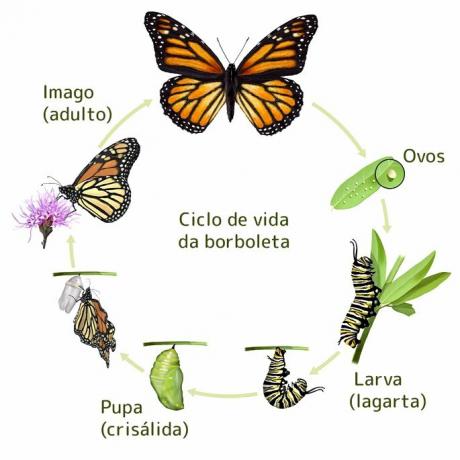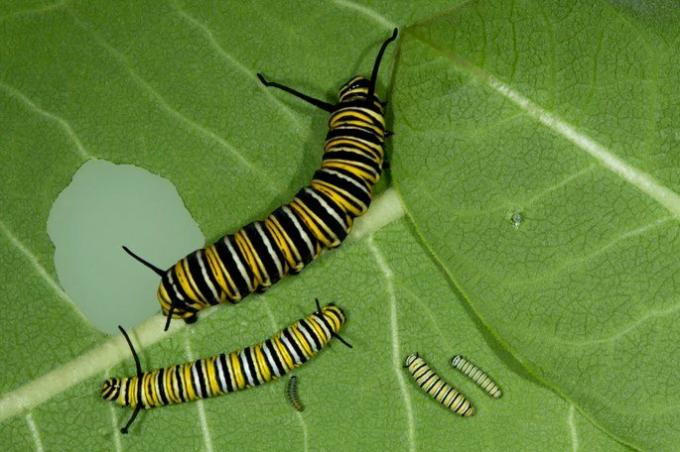Butterfly metamorphosis is the transformation process that occurs in the body of this animal. Butterflies belong to the class of insects and are animals holometaboles, that is, they carry out complete metamorphosis and with major changes in their organisms.
Butterflies go through four phases during their life, they are: egg larva
pupa
imago.
The eggs contain the embryos of the new organisms that will be born. Once they hatch, larvae emerge from the eggs, also known as caterpillars. At the right time, the caterpillars form a pupa, a type of cocoon, also called a chrysalis, to transform into a butterfly (imago) at the end of the cycle.
Butterfly life cycle
Insects reproduce by laying eggs and, depending on the species, they may be ametabolous, hemimetabolous or holometabolous.
Ametabolous animals do not undergo metamorphosis and hemimetabolous animals undergo partial metamorphosis. Butterflies and moths, animals of the Order Lepidoptera, are holometabolous, therefore, they undergo complete metamorphosis.

butterfly eggs
Butterflies, like other insects, lay their eggs (oviposition) on previously chosen plant leaves. Egg laying takes place on the top of the leaf, also known as the adaxial region.
Egg shape, quantity and distance between eggs differ between species. However, they usually lay between 10 and 30 eggs 1 millimeter apart.
Hatching usually varies from 3 to 5 days, according to the doctoral thesis by Márcio Carvalho from UNICAMP. The author studied the early stages of the species Mechanitis polymnia.
The size of the eggs varies from 1.0 to 1.2 millimeters in height to 0.7 millimeters in diameter. The species has whitish eggs with an elliptical shape, that is, with ends that are larger than their width.
Therefore, the color, shape and number of eggs will vary depending on the species of butterfly.
Know more: Characteristics of insects

Butterfly larva - Caterpillar
The larval stage, also known as the caterpillar, is an important stage in the development of the butterfly. During this period, the body will struggle to obtain food for its nutrition and growth.
When the eggs hatch, they usually eat the chorion, the protein-rich envelope of the embryo, and begin their diet in the central region of the leaf. When finished, they move to the leaf margins to continue feeding.
Caterpillars go through phases well studied by experts, these phases are called urge. Butterflies from the Nymphalidae group usually go through five instars. In each instar the specimen goes through growth and maturation until it can produce its pupa / chrysalis.

Butterfly Pupa - Chrysalis
During instars, the caterpillar changes its color, size and brain capsule to prepare for the pupal stage. The pupa, also known as the chrysalis, is the stage of maturation in which the larva goes through to transform into an adult (imago).
The size, coloration and time spent in the pupa will differ from species to species. It is usually possible to check the color of the adult's wings in the final days.
Butterflies of the species Mechanitis polymnia they form a transparent yellow chrysalis and later turn metallic silver. Its length is approximately 16 millimeters and its development takes place in 7 to 8 days.

Adult butterfly - Imago
Upon leaving the pupa, the organism remains still to stretch its wings, configuring its full maturation.
From this moment on, the animal will be able to carry out its natural activities, such as feeding and pollinating various plant species.
The lifespan of an adult butterfly varies from species to species. An owl butterfly (Caligo eurilochus brasiliensis) can live for more than three months, however, others only live for a few weeks.

Know more:
- Metamorphosis of animals;
- Arthropods.
Bibliographic references
CARVALHO, MÁRCIO ROMERO MARQUES. Host plant selection, larval performance and description of immature stages in the butterfly Mechanitis polymnia (Haensch, 1905)(Nymphalidae, Danainae). 2019.
CASTILHO, Rubens. Butterfly metamorphosis: understand the cycle, from egg to adult.All Matter, [n.d.]. Available in: https://www.todamateria.com.br/metamorfose-da-borboleta/. Access at:
See too
- Metamorphosis of Animals
- Insects
- Arthropods
- Bees
- Types of flowers and their functions
- Pollination
- Ants
- Internal and External Fertilization


